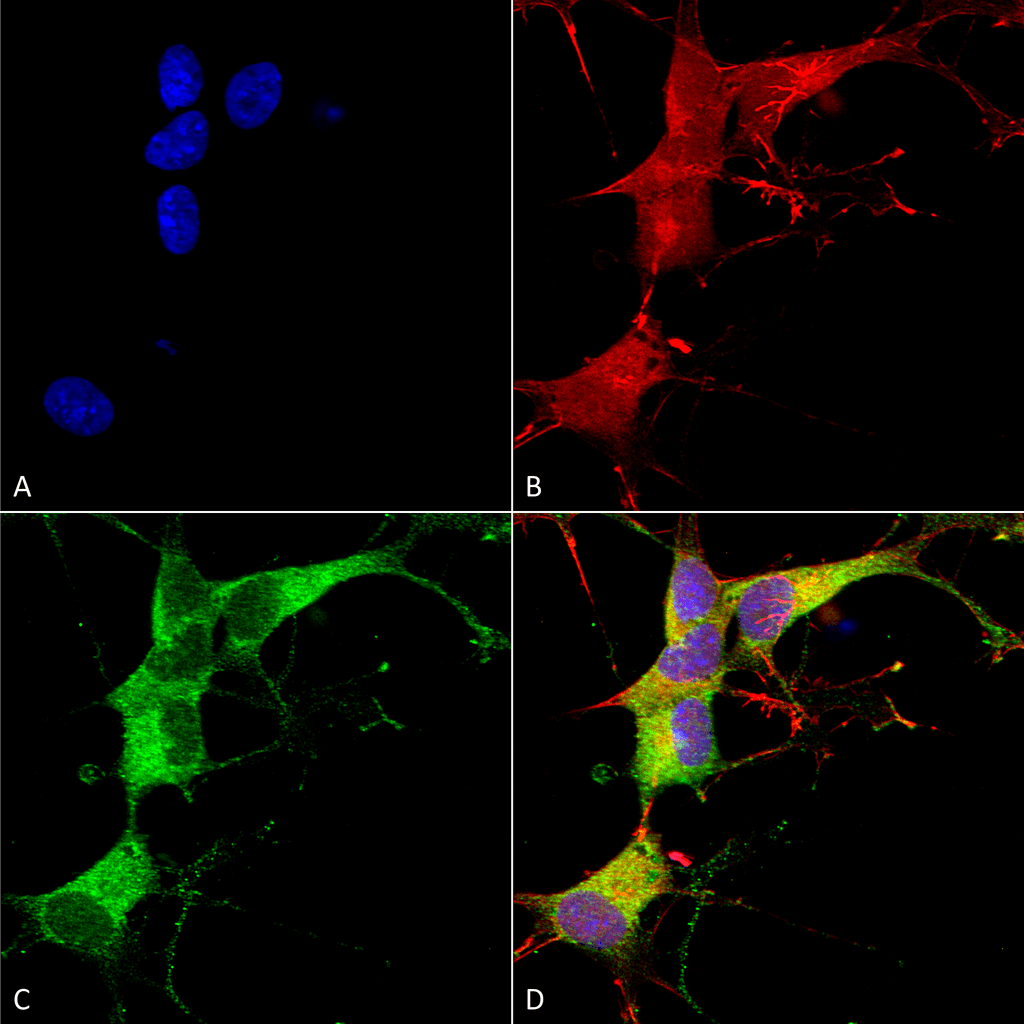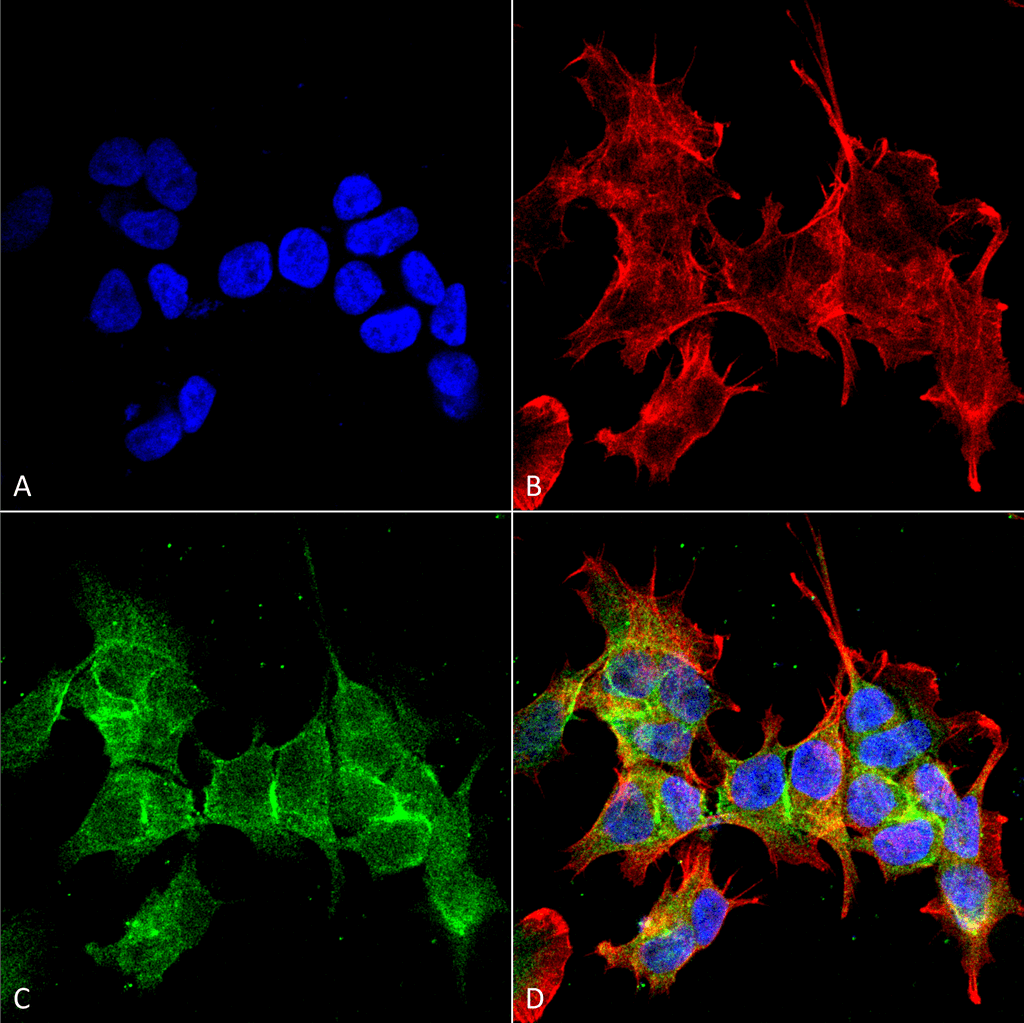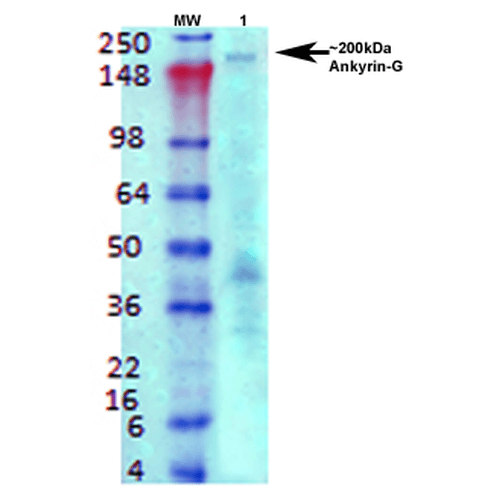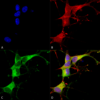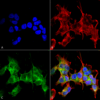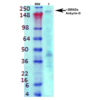Anti-Ankyrin-G Antibody (56519)
$466.00
SKU: 56519
Categories: Antibody Products, Neuroscience and Signal Transduction Antibodies, Products
Overview
Product Name Anti-Ankyrin-G Antibody (56519)
Description Anti-Ankyrin-G Mouse Monoclonal Antibody
Target Ankyrin-G
Species Reactivity Human, Mouse, Rat
Applications WB,ICC/IF
Host Mouse
Clonality Monoclonal
Clone ID S106-20
Isotype IgG1
Immunogen Fusion protein corresponding to ~1,000 C-terminal amino acids of human Ankyrin G (accession no. NP_066267.2).
Properties
Form Liquid
Concentration 1.0 mg/mL
Formulation PBS, pH 7.4, 50% glycerol, 0.09% sodium azide.Purified by Protein G affinity chromatography.
Buffer Formulation Phosphate Buffered Saline
Buffer pH pH 7.4
Buffer Anti-Microbial 0.09% Sodium Azide
Buffer Cryopreservative 50% Glycerol
Format Purified
Purification Purified by Protein G affinity chromatography
Specificity Information
Specificity This antibody recognizes human, mouse, and rat Ankyrin-G.
Target Name Ankyrin-3
Target ID Ankyrin-G
Uniprot ID Q12955
Alternative Names ANK-3, Ankyrin-G
Gene Name ANK3
Sequence Location Cytoplasm, cytoskeleton, Cell projection, axon, Cell membrane, sarcolemma, Cell junction, synapse, postsynaptic cell membrane, Lysosome, Cell membrane, sarcolemma, T-tubule
Biological Function In skeletal muscle, required for costamere localization of DMD and betaDAG1 (By similarity). Membrane-cytoskeleton linker. May participate in the maintenance/targeting of ion channels and cell adhesion molecules at the nodes of Ranvier and axonal initial segments. Regulates KCNA1 channel activity in function of dietary Mg(2+) levels, and thereby contributes to the regulation of renal Mg(2+) reabsorption (PubMed:23903368). {PubMed:17974005}.; [Isoform 5]: May be part of a Golgi-specific membrane cytoskeleton in association with beta-spectrin. {PubMed:17974005}.
Research Areas Neuroscience
Background Ankyrins are a family of adaptor proteins that mediate the attachment of integral membrane proteins to the spectrin-actin based membrane skeleton. Ankyrins have binding sites for the beta subunit of spectrin and for at least 12 families of integral membrane proteins. This linkage is required to maintain the integrity of the plasma membranes and to anchor specific ion channels, ion exchangers, and ion transporters in the plasma membrane.
Application Images




Description Immunocytochemistry/Immunofluorescence analysis using Mouse Anti-Ankyrin G Monoclonal Antibody, Clone S106-20 (56519). Tissue: Neuroblastoma cells (SH-SY5Y). Species: Human. Fixation: 4% PFA for 15 min. Primary Antibody: Mouse Anti-Ankyrin G Monoclonal Antibody (56519) at 1:100 for overnight at 4°C with slow rocking. Secondary Antibody: AlexaFluor 488 at 1:1000 for 1 hour at RT. Counterstain: Phalloidin-iFluor 647 (red) F-Actin stain; Hoechst (blue) nuclear stain at 1:800, 1.6mM for 20 min at RT. (A) Hoechst (blue) nuclear stain. (B) Phalloidin-iFluor 647 (red) F-Actin stain. (C) Ankyrin G Antibody (D) Composite.

Description Immunocytochemistry/Immunofluorescence analysis using Mouse Anti-Ankyrin G Monoclonal Antibody, Clone S106-20 (56519). Tissue: Neuroblastoma cell line (SK-N-BE). Species: Human. Fixation: 4% Formaldehyde for 15 min at RT. Primary Antibody: Mouse Anti-Ankyrin G Monoclonal Antibody (56519) at 1:100 for 60 min at RT. Secondary Antibody: Goat Anti-Mouse ATTO 488 at 1:200 for 60 min at RT. Counterstain: Phalloidin Texas Red F-Actin stain; DAPI (blue) nuclear stain at 1:1000, 1:5000 for 60 min at RT, 5 min at RT. Localization: Cytoplasm . Magnification: 60X. (A) DAPI (blue) nuclear stain. (B) Phalloidin Texas Red F-Actin stain. (C) Ankyrin G Antibody. (D) Composite.

Description Western Blot analysis of Rat brain membrane lysate showing detection of Ankyrin G protein using Mouse Anti-Ankyrin G Monoclonal Antibody, Clone S106-20 (56519). Primary Antibody: Mouse Anti-Ankyrin G Monoclonal Antibody (56519) at 1:1000.
Handling
Storage This product is stable for at least 1 year at -20°C. Freeze in multiple aliquots to avoid repeated freeze-thaw cycles.
Dilution Instructions Dilute in PBS or medium that is identical to that used in the assay system.
Application Instructions Immunoblotting: use at 1-2ug/mL. A band of >200kDa is detected.
These are recommended concentrations.
Enduser should determine optimal concentrations for their applications.
Positive control: rat brain membranes.
These are recommended concentrations.
Enduser should determine optimal concentrations for their applications.
Positive control: rat brain membranes.
References & Data Sheet
Data Sheet  Download PDF Data Sheet
Download PDF Data Sheet
 Download PDF Data Sheet
Download PDF Data Sheet

